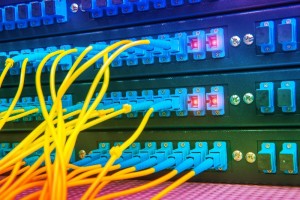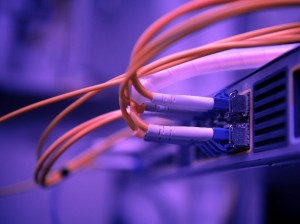Fiber Optic Cabling Installations


“RADCommunications is considered by IT professionals nationwide as one of the most knowledgeable & skilled fiber optic installation cabling companies in the structured cabling industry today.”
Fiber optic data cabling allows communication signals to be transmitted much faster, at a higher bandwidth and over much greater distances. Fiber optic cabling cabling is also impervious to interference, with a much lower transmission loss resulting in a more robust solution especially when it come to your network infrastructure backbone and riser system cabling.
Fiber-optic benefits include:
- Impervious to Electromagnetic Interference (EMI): EMI is a disturbance generated by an external source that affects an electrical circuit by electromagnetic induction, electrostatic coupling, or conduction. The disturbance may degrade the performance of the circuit or even stop it from functioning. In the case of a data path, these effects can range from an increase in error rate to a total loss of the data.
- High Bandwidth: A high range frequency used to transmit a signal. This type of bandwidth is measured in hertz and is often referenced in signal processing applications.
- Security: There are no radiated magnetic fields around optical fibers; the electromagnetic fields are confined within the fiber. That makes it impossible to tap the signal being transmitted through a fiber without cutting into the fiber. Since fiber optics do not radiate electromagnetic energy, emissions cannot be intercepted and physically tapping the fiber takes great skill to do undetected. Thus, the fiber is the most secure medium available for carrying sensitive data.
 Design: Fiber cables are often easier to install when compared with copper, especially copper trunk cables since fiber optic cables are typically smaller in diameter and more flexible. They can also run along the same routes as electric cables without picking up interference from excessive noise. Other than speed this is to be considered one of its greatest attributes.
Design: Fiber cables are often easier to install when compared with copper, especially copper trunk cables since fiber optic cables are typically smaller in diameter and more flexible. They can also run along the same routes as electric cables without picking up interference from excessive noise. Other than speed this is to be considered one of its greatest attributes. - Migration: Fiber-optic cabling basically enables you to future-proof your cabling infrastructure systems. It guarantees the allowance of connectivity to the next generations of hardware without the need of another cabling installation. Furthermore it provides a platform that is robust, efficient and simple to operate.
Contact us today to learn more about your next fiber installation.


